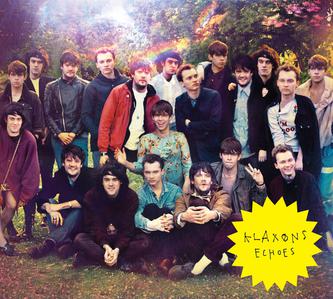In 2010, after years of silence and a tidal wave of early hype, Klaxons resurfaced — not to reclaim their old crown, but to throw it into the void and walk away. Their return single, “Echoes”, didn’t just mark a comeback. It was a reintroduction — sharper edges, heavier weight, and a deliberate step away from the neon chaos of “new rave” that first made their name.
No more trying to define a scene. No more chasing the high of their debut. Echoes was something else entirely.

The track doesn’t kick in. It opens — like a slow sunrise on another planet. Wide, airy synths stretch out into the distance. Guitars slice through with precision instead of noise. And then Jamie Reynolds’ vocals arrive — steady, distant, but certain.
He’s not shouting anymore. He’s delivering. There’s urgency, yes, but without the panic that colored their earlier work. That control changes the whole impact. This isn’t a race to the chorus — it’s a measured push forward.
Bringing in Ross Robinson — the producer best known for shaping heavyweights like Slipknot, Korn, and Glassjaw — looked like an odd move on paper. But on record, it made perfect sense.
Robinson’s touch gave Echoes a density that carried weight without crushing the atmosphere. The track feels polished but still a little raw, with grit buried under the clean lines. It’s a balance between clarity and tension — the exact space Klaxons wanted to live in.
Lyrically, Echoes never spells itself out. It drifts between philosophy and dream imagery — like a message breaking up through static. You’re not meant to decode it line by line. You’re meant to let it wash through you.
The official video, released July 19, 2010, took the song’s atmosphere and turned it into something visual: a surreal desert that looks like Mars redesigned by a minimalist. The band moves through it like travelers who’ve been stuck between worlds too long — isolated, wide open, and carrying that quiet urgency the song breathes.
As the first single from Surfing the Void, Echoes set the tone for a record that was never going to be Myths of the Near Future, Part Two. That debut was neon, fast, and youthful. This was stranger, heavier, and sometimes rougher. But Echoes stood out because it carried just enough of the past to feel familiar — while pointing directly into the unknown.
Klaxons could have played it safe. They didn’t. Instead, they built something colder, more open, and more controlled. No gimmicks. Just sound, space, and a feeling you can’t quite name — but can’t shake either.
If you want, I can also rework this into a mock Q&A with Jamie Reynolds and Ross Robinson, so it reads like they’re walking us through the creative shift that birthed Echoes. That could make it feel even more personal and behind-the-scenes.
